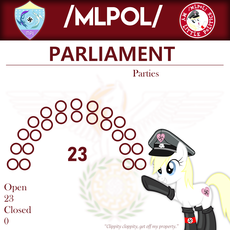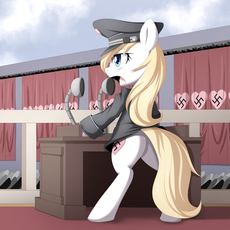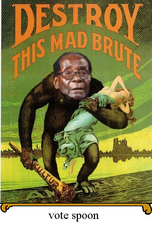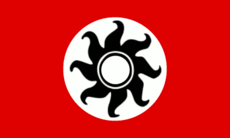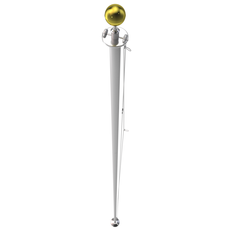Let’s play a game /mlpol/. We create a parliament and create board rules and make other things regarding the board.
>How does it work.
Step one, we need some political parties. For a party to exist you need to write up a party manifesto make a logo and chose a color. The manifesto must also state where you lie on political issues, this can be super broad or very specific, but the more people that understand what you stand for the easier it'll be to get anons to vote for your party. It also might be helpful to name/tripfag if you create a party. Here an example:
Party Party Not a real party as of now
Manifesto:
1. /mlpol/ is a fun board.
2. /mlpol/ is a nice board.
3. Being no fun will not be allowed. If you are not fun, you'll be BANNED!
4. If you’re a commie you’re not fun.
5. On Sunday you need to post horse pussy at least once or you’re not being fun.
Stance on issues is conservative center left. Distributism is good if effective. But destroying traditions is no fun!
Ect
As soon as we get two parties up and running the two parties will get one seat each seat and all parties that join will also get two seats. There is a 10-party cap so that we don't have a terribly large amount of anons making parties that are very similar.
After the parties are formed we can get to the meat of it which is anons voting. The votes here will work differently. Say which party you want to join and the party will be given an extra seat. Your vote can also be used to remove a seat from a political party. Everyone including party founders get three votes with their ID for max chaos. The game will continue till we reach 23, and as soon as its hit voting is over.
Once voting is over we can go full LARP and each party leader, or the person who made the party and wrote the manifesto, will chose anons who loyally voted for him to become members of parliament. Here we will draft legislation and make arbitrary rules based on the manifesto. All which will be non-binding unless, say the mods for whatever reason don't veto it when it leaves the lower house of parliament.
SO LET THE GAMES BEGIN!
/go/ - Golden Oaks
Thread Repository
441 replies and 149 files omitted.
>>3140
I think we decided on proportionate representation as well so there should be no problem with additional parties.
I think we decided on proportionate representation as well so there should be no problem with additional parties.
>>3142
Joking.
>>3135
The First Bank of the US was used in order to stabilise the nations credit post-war, albeit I don't agree with the privatised aspect, but it didn't necessarily function as a national bank does today. The debt issued couldn't exceed capitalisation and was funded by tax to a degree. Checking the stockholder's; which would be the problem; but it turns out foreign stockholders had no vote for the private company. I suppose there can be scrutiny towards whoever held stock as a citizen of the US, however this had to be documented as malevolent for me to call it evil. In the end, after expiring the bank's stocks were sold and there was no debt incurred by it. As for conspiracy, I'm not a believer. Hamilton's proposal did some good as a stepping stone like a national mint. I believe the old opposition was mostly derived from the role of the federal state, unlike the reasons why it is scrutinised today.
Joking.
>>3135
The First Bank of the US was used in order to stabilise the nations credit post-war, albeit I don't agree with the privatised aspect, but it didn't necessarily function as a national bank does today. The debt issued couldn't exceed capitalisation and was funded by tax to a degree. Checking the stockholder's; which would be the problem; but it turns out foreign stockholders had no vote for the private company. I suppose there can be scrutiny towards whoever held stock as a citizen of the US, however this had to be documented as malevolent for me to call it evil. In the end, after expiring the bank's stocks were sold and there was no debt incurred by it. As for conspiracy, I'm not a believer. Hamilton's proposal did some good as a stepping stone like a national mint. I believe the old opposition was mostly derived from the role of the federal state, unlike the reasons why it is scrutinised today.
>>3143
Regardless, people view Hamilton as the origin of the US debt crisis and the origin for the idea of the Federal Reserve, and some hate him on the same level as Wilson for giving the Federal Reserve the power to order the mint to print money.
Personally, I'm against any and all privatization of the financial services, and I view said privatization as the reason for many of our financial ills because the bankers and stockbrokers only hold loyalty to money: not to the nation, its people, or the world at large, and that their deviancy has led to several generations of Americans who believe that money comes out of thin air and that it's fine to take out ungodly amounts of loans that banks honestly don't have the actual money to pay out.
Sorry if this post is loaded with ranting. I just really, really hate private banks.
Regardless, people view Hamilton as the origin of the US debt crisis and the origin for the idea of the Federal Reserve, and some hate him on the same level as Wilson for giving the Federal Reserve the power to order the mint to print money.
Personally, I'm against any and all privatization of the financial services, and I view said privatization as the reason for many of our financial ills because the bankers and stockbrokers only hold loyalty to money: not to the nation, its people, or the world at large, and that their deviancy has led to several generations of Americans who believe that money comes out of thin air and that it's fine to take out ungodly amounts of loans that banks honestly don't have the actual money to pay out.
Sorry if this post is loaded with ranting. I just really, really hate private banks.
>>3145
What is your view on currency in general? Is it controlled by billionaires and the stock market and we should move to something else? Or is it ok but these banks are a problem. It’s a bit off topic, but I’m curious.
What is your view on currency in general? Is it controlled by billionaires and the stock market and we should move to something else? Or is it ok but these banks are a problem. It’s a bit off topic, but I’m curious.
>>3145
>1
I wouldn't necessarily contribute those issues to him at all. His presidency didn't significantly cause expansive debt (kind of opposite), US national debts incurred after were repaid, the US has had time since to solve the "debt crisis", the first real surplus was during Clinton's era, and so the US is tackling the issue all wrong. Austerity hasn't done anything, but actually run budget deficits, so it leads me to believe its only goal is market fundamentalism.
The Federal Reserve has made many mistakes, and I would suggest a better national bank not headed by Wall Street Tycoons. Also, the Federal Reserve doesn't order the mint to make money. Banks create money:
www.monetary.org/wp-content/uploads/2016/03/money-creation-in-the-modern-economy.pdf
"Whenever a bank makes a loan, it simultaneously creates a matching deposit in the borrower’s bank account, thereby creating new money."
I agree with the second point, besides how money is created out of thin air. It is, so the issue is reigning in banks. My hopeful solution to this is cutting out the middle men with Central Bank Digital Currency:
https://en.wikipedia.org/wiki/Central_Bank_Digital_Currency
Which allows complete and efficient monetary control unlike today.
>1
I wouldn't necessarily contribute those issues to him at all. His presidency didn't significantly cause expansive debt (kind of opposite), US national debts incurred after were repaid, the US has had time since to solve the "debt crisis", the first real surplus was during Clinton's era, and so the US is tackling the issue all wrong. Austerity hasn't done anything, but actually run budget deficits, so it leads me to believe its only goal is market fundamentalism.
The Federal Reserve has made many mistakes, and I would suggest a better national bank not headed by Wall Street Tycoons. Also, the Federal Reserve doesn't order the mint to make money. Banks create money:
www.monetary.org/wp-content/uploads/2016/03/money-creation-in-the-modern-economy.pdf
"Whenever a bank makes a loan, it simultaneously creates a matching deposit in the borrower’s bank account, thereby creating new money."
I agree with the second point, besides how money is created out of thin air. It is, so the issue is reigning in banks. My hopeful solution to this is cutting out the middle men with Central Bank Digital Currency:
https://en.wikipedia.org/wiki/Central_Bank_Digital_Currency
Which allows complete and efficient monetary control unlike today.
>>3146
>What is your view on currency in general?
Sparta was right, gold and silver currency should be banned, if you must do business do it in Iron obols, or it's equivalent in this day and age, guns and ammo.
>What is your view on currency in general?
Sparta was right, gold and silver currency should be banned, if you must do business do it in Iron obols, or it's equivalent in this day and age, guns and ammo.
>>3148
Sounds good to me. Good old barter. It’s hard for the government and billionaires to mess with exchange of goods on such a simple level. Plus it’s hard to tax.
Sounds good to me. Good old barter. It’s hard for the government and billionaires to mess with exchange of goods on such a simple level. Plus it’s hard to tax.
>>3146
I believe the idea behind currency is overall a good thing. However:
1. I believe the issuing of currency is one of the basic rights of all sovereign nations, and that no private organization has the right to create legal tender on behalf of a nation, whether it was given permission or not. The central government should control the national bank and the ordering of new currency only.
2. Using oil to back the dollar is one of the most self-destructive things that we have ever done. Same goes for silver and gold, and the double standard. We need to back our currencies behind something that is both universally held as being valuable, and isn't prone to rarity, localization, or simply just running out.
>>3147
Forgive me for my ignorance. Economics has never been my strong suit.
This digital currency sounds good on paper, but I'm a bit concerned that, in our digital age, where the people in charge are so technologically inept that they still think that "password" is a good password, that it will remain secure for long.
Now that I think on it, though, money isn't secure as it is, so It might be a moot point.
I believe the idea behind currency is overall a good thing. However:
1. I believe the issuing of currency is one of the basic rights of all sovereign nations, and that no private organization has the right to create legal tender on behalf of a nation, whether it was given permission or not. The central government should control the national bank and the ordering of new currency only.
2. Using oil to back the dollar is one of the most self-destructive things that we have ever done. Same goes for silver and gold, and the double standard. We need to back our currencies behind something that is both universally held as being valuable, and isn't prone to rarity, localization, or simply just running out.
>>3147
Forgive me for my ignorance. Economics has never been my strong suit.
This digital currency sounds good on paper, but I'm a bit concerned that, in our digital age, where the people in charge are so technologically inept that they still think that "password" is a good password, that it will remain secure for long.
Now that I think on it, though, money isn't secure as it is, so It might be a moot point.
>>3150
I don't expect it to fully replace paper fiat, however it should transcend all the barriers of money exchange digitally, make money more accessible (so it's destroyed less), and importantly make banking accessible to all without the fears of fractional reserve banking. Which it will compete against. Each person will be entitled a national banking account. If someone literally can't remember a password, they shouldn't have a banking account in the first place (maybe they're mentally retarded.)
I don't expect it to fully replace paper fiat, however it should transcend all the barriers of money exchange digitally, make money more accessible (so it's destroyed less), and importantly make banking accessible to all without the fears of fractional reserve banking. Which it will compete against. Each person will be entitled a national banking account. If someone literally can't remember a password, they shouldn't have a banking account in the first place (maybe they're mentally retarded.)
>>3150
Although our economy is backed by oil, the dollar is technically put in place by the power of the government. It prints it and says it’s money, but it’s just paper. The reason it has worth is because we agree we can use it. The economy used to judge the overall worth of the paper is based in oil exchange now though. So that is a major problem.
And yeah, I don’t trust digital currency from both a logical stance and religiously. You want to go from being able to physically hold your money to institutions promising you got it in their system. Just be a good goy or we will not only shut you down, but your money too.
Then there is Revelation 13:17
And that no man might buy or sell, save he that had the mark, or the name of the beast, or the number of his name.
Now, how can people be denied any trade if there was still a physical currency of some sort? Seems like digital currency may be the future, but not necessarily the best one.
>>3151
And you just proved my point. Available to all (that obey) and are entitled to it for being a good goy. Be careful Epona worshipper, you may fall into a jewish trap with centralized digital currency.
Although our economy is backed by oil, the dollar is technically put in place by the power of the government. It prints it and says it’s money, but it’s just paper. The reason it has worth is because we agree we can use it. The economy used to judge the overall worth of the paper is based in oil exchange now though. So that is a major problem.
And yeah, I don’t trust digital currency from both a logical stance and religiously. You want to go from being able to physically hold your money to institutions promising you got it in their system. Just be a good goy or we will not only shut you down, but your money too.
Then there is Revelation 13:17
And that no man might buy or sell, save he that had the mark, or the name of the beast, or the number of his name.
Now, how can people be denied any trade if there was still a physical currency of some sort? Seems like digital currency may be the future, but not necessarily the best one.
>>3151
And you just proved my point. Available to all (that obey) and are entitled to it for being a good goy. Be careful Epona worshipper, you may fall into a jewish trap with centralized digital currency.
>>3152
I don't understand. Either the US or Canadian government is already in full sovereign control of its currency. How is making its control more efficient Jewry? In fact, debt jubilees can efficiently be carried out this way to save governments of their private debt crises.
I don't understand. Either the US or Canadian government is already in full sovereign control of its currency. How is making its control more efficient Jewry? In fact, debt jubilees can efficiently be carried out this way to save governments of their private debt crises.
>>3154
Is the government being usurped by jews? If yes, then more control over who gets access to the only way to exchange goods is more than enough cause for concern. If not, then one day the jew will work his way into the system. It’s just a matter of time.
Is the government being usurped by jews? If yes, then more control over who gets access to the only way to exchange goods is more than enough cause for concern. If not, then one day the jew will work his way into the system. It’s just a matter of time.
>>3157
That's why you expel the Jews. Supposedly the Jews already control everything, states and markets. It's hard to pick out good ideas if everything is foiled by Jews, so I will set to remove them and then implementation comes.
That's why you expel the Jews. Supposedly the Jews already control everything, states and markets. It's hard to pick out good ideas if everything is foiled by Jews, so I will set to remove them and then implementation comes.
>>3159
That would definitely be nice. I see a problem though. Moving toward this goal prematurely, aka: before the (((problem))) is removed, then we will see the prophecy fulfilled. And seeing how the pieces are in place for such a system, the jews won’t be removed before they try and set the system up.
Not to mention the other parts of the prophecy about how the Antichrist comes to save the jew from the nations of the world, then controls them and all... but that is for another thread I believe.
That would definitely be nice. I see a problem though. Moving toward this goal prematurely, aka: before the (((problem))) is removed, then we will see the prophecy fulfilled. And seeing how the pieces are in place for such a system, the jews won’t be removed before they try and set the system up.
Not to mention the other parts of the prophecy about how the Antichrist comes to save the jew from the nations of the world, then controls them and all... but that is for another thread I believe.
>>3160
Alright, alright. It's been interesting. I often don't get to talk about heterodox economic thinking.
Alright, alright. It's been interesting. I often don't get to talk about heterodox economic thinking.
>>3163
I like it too. Anytime you want to continue, I would be glad to, but I just think we shouldn’t spam this thread. We kind of got off track from parliament.
I like it too. Anytime you want to continue, I would be glad to, but I just think we shouldn’t spam this thread. We kind of got off track from parliament.
>>3150
>We need to back our currencies behind something that is both universally held as being valuable, and isn't prone to rarity, localization, or simply just running out.
Violence. Violence is the best backing for any currency.
>We need to back our currencies behind something that is both universally held as being valuable, and isn't prone to rarity, localization, or simply just running out.
Violence. Violence is the best backing for any currency.
>>3165
Hi. Welcome to McDonald’s. You want a burger with fries and a soft drink? Ok. Come inside. That will be 2 broken bones, a concussion, and a black eye. Thank you and have a nice trip to the hospital today.
Hi. Welcome to McDonald’s. You want a burger with fries and a soft drink? Ok. Come inside. That will be 2 broken bones, a concussion, and a black eye. Thank you and have a nice trip to the hospital today.
>>3166
and of course a gold backed currency requires actually handing over bricks of shiny yellow metal.
and of course a gold backed currency requires actually handing over bricks of shiny yellow metal.
Few overall points from your best allies.
>It's just a game.
We won't probably have any impact on the whole site, if you want somethign to change you don't need to go through that whole parliment thing, just make your own thread, contact mods etc. so instead let's focus on having some fun with our LARP.
>Add some (((diversity))) *rubs hands*
I understand that everyone wants to be in party that aligns with their views, it's great and all, but then we end with 10 vaguely right-wing parties and threads full of people arguing that their right-wing brand is better than other right-wing brands.
We don't need any parliment or elections for that, we can do it in any other thread.
It would be better to focus on having fun, LARPing as politicians and shit like that.
If all parties have just some minor differences but in the end are pretty close and agree on many issues then where's some conflict? If all parties can be in one coalition then there is really no point in having so many of them.
This whole idea has big potentiall, you can have soiboi party, feminist party, anarchists, gommies, niggnogs, or caricatural /nu/pol party with wehraboos, skinheads and being triggered at everything. We just need some people other than me willing to do it.
I also warn you, if you kill my joos, they will rise 10 times stronger.
>It's just a game.
We won't probably have any impact on the whole site, if you want somethign to change you don't need to go through that whole parliment thing, just make your own thread, contact mods etc. so instead let's focus on having some fun with our LARP.
>Add some (((diversity))) *rubs hands*
I understand that everyone wants to be in party that aligns with their views, it's great and all, but then we end with 10 vaguely right-wing parties and threads full of people arguing that their right-wing brand is better than other right-wing brands.
We don't need any parliment or elections for that, we can do it in any other thread.
It would be better to focus on having fun, LARPing as politicians and shit like that.
If all parties have just some minor differences but in the end are pretty close and agree on many issues then where's some conflict? If all parties can be in one coalition then there is really no point in having so many of them.
This whole idea has big potentiall, you can have soiboi party, feminist party, anarchists, gommies, niggnogs, or caricatural /nu/pol party with wehraboos, skinheads and being triggered at everything. We just need some people other than me willing to do it.
I also warn you, if you kill my joos, they will rise 10 times stronger.
>>3170
I see your point, but no one wants the wrath of the community to destroy their party in one fell swoop by setting up a leftist party. It’s that survival instinct at work, I suppose, that keeps people from making a party that’s people here will hate.
I see your point, but no one wants the wrath of the community to destroy their party in one fell swoop by setting up a leftist party. It’s that survival instinct at work, I suppose, that keeps people from making a party that’s people here will hate.
The Honey Nut Cheerios Party is very pro business, only intervening in cases where the health and safety of the nation is at risk. There will be little regulation aside from that for the greater health of the nation.
We are also pro military, as we wish to protect ourselves from threats at home and abroad, and to make sure the rest of the world gets a good breakfast!
Education will be well funded, after all, a well informed citizen is a healthy citizen!
The rights of the people will be kept dear, as we don't want to restrict their freedoms, as long as it's not hurting anyone.
Aside from that, our only policies are those that achieve our stated goals!
We are also pro military, as we wish to protect ourselves from threats at home and abroad, and to make sure the rest of the world gets a good breakfast!
Education will be well funded, after all, a well informed citizen is a healthy citizen!
The rights of the people will be kept dear, as we don't want to restrict their freedoms, as long as it's not hurting anyone.
Aside from that, our only policies are those that achieve our stated goals!
>>3173
Jews are a threat to the health of everyone. They will compromise both the health and safety of everyone by having any power in the government and business, and therefore, will not be allowed to be a citizen or live in our nation.
Jews are a threat to the health of everyone. They will compromise both the health and safety of everyone by having any power in the government and business, and therefore, will not be allowed to be a citizen or live in our nation.
>>3123
>>3125
>>3134
I don't appreciate this slander. One non-leading member stepped out of line and agreed with (((them))) and you accuse us of being corrupted. We're in full support of physical removal by private activism.
Anyway, this is going off topic. We need to establish election reform. Rather than debate endlessly about details we ought to establish a set of general principles and work from there.
I propose:
1) Electorate based on districts set within a map of Equestria;
2) Weekly or fortnightly voting with votes cast in one district not applicable to another;
3) Seats that allow every party member a voice (despite the harm it has caused me), yet is more flexible than a pure headcount;
4) Standing coalitions
5) A Head of Parliament whose primary purpose is to convene and adjourn sessions and to update the map.
The last is most important. Without even such a ceremonial role we have already been reduced to bickering about unrelated topics.
>>3125
>>3134
I don't appreciate this slander. One non-leading member stepped out of line and agreed with (((them))) and you accuse us of being corrupted. We're in full support of physical removal by private activism.
Anyway, this is going off topic. We need to establish election reform. Rather than debate endlessly about details we ought to establish a set of general principles and work from there.
I propose:
1) Electorate based on districts set within a map of Equestria;
2) Weekly or fortnightly voting with votes cast in one district not applicable to another;
3) Seats that allow every party member a voice (despite the harm it has caused me), yet is more flexible than a pure headcount;
4) Standing coalitions
5) A Head of Parliament whose primary purpose is to convene and adjourn sessions and to update the map.
The last is most important. Without even such a ceremonial role we have already been reduced to bickering about unrelated topics.
>>3176
Also, a formal PFP announcement.
If Ancap-anon's inactivity if he does not reply to this message in 24 hours I shall reassume direct control as Party President.
Also, a formal PFP announcement.
If Ancap-anon's inactivity if he does not reply to this message in 24 hours I shall reassume direct control as Party President.
>>3176
Oh look another one that's pro federalism. Not surprised though. I will not support any plan that divides the board. Your other proposals are made with good intent but I cannot support any system that'll decentralize our vote into arbitrary districts that mean nothing to the members of /mlpol/. As soon as this proposal inevitably fails I will create my own bill for election reform that'll truly fix /mlpol/'s election problems.
Oh look another one that's pro federalism. Not surprised though. I will not support any plan that divides the board. Your other proposals are made with good intent but I cannot support any system that'll decentralize our vote into arbitrary districts that mean nothing to the members of /mlpol/. As soon as this proposal inevitably fails I will create my own bill for election reform that'll truly fix /mlpol/'s election problems.
>>3178
I've seen your views on the electoral reform, and as a member of the SDWHP I would throw my support behind you.
I've seen your views on the electoral reform, and as a member of the SDWHP I would throw my support behind you.
>>3178
I would have normally agreed with you should this political system actually have power. But this is simply a game where a single unified state simply limits the potential of interesting debates and situations for the parties do deal with. I support districts.
Now if the districts agree to merge at a later date there is nothing to stop them from doing so. That can be a major campaigning platform, showing how the districts are failing and need to converge, should that be the case.
I would have normally agreed with you should this political system actually have power. But this is simply a game where a single unified state simply limits the potential of interesting debates and situations for the parties do deal with. I support districts.
Now if the districts agree to merge at a later date there is nothing to stop them from doing so. That can be a major campaigning platform, showing how the districts are failing and need to converge, should that be the case.
>>2738
I present to /mlpol/ the April First Party's election reform rule change bill.
1. Voting will take place in a new thread every Sunday.
2. In order for your vote to be counted you need to type V in the subject line.
3. Every anon will have 2 votes he can use to vote separately for a party and 1 against.
4. When an anon votes he must cast all his ballets at once or forfeit his ability to cast it for others latter.
5. Unlimited amounts of parties can enter into the election but they must have 3 separate anons other then the party founder state that the party should be allowed into the general election.
6. Make the total number of seats in the parliament at 27 instead of 23.
7. Make the parliament a percentage proportional representation system.
I present to /mlpol/ the April First Party's election reform rule change bill.
1. Voting will take place in a new thread every Sunday.
2. In order for your vote to be counted you need to type V in the subject line.
3. Every anon will have 2 votes he can use to vote separately for a party and 1 against.
4. When an anon votes he must cast all his ballets at once or forfeit his ability to cast it for others latter.
5. Unlimited amounts of parties can enter into the election but they must have 3 separate anons other then the party founder state that the party should be allowed into the general election.
6. Make the total number of seats in the parliament at 27 instead of 23.
7. Make the parliament a percentage proportional representation system.
>>3183
There's parts of this I dislike, the reduction and limitation on votes and the difficulty of starting new parties for instance, but that's the price paid for not making my own proposal. Hopefully this can be further amended someday to adress those issues, but seeing as we are on the eve of the weekend and we need a solution now;
The Stern Disappointment With Hitler Party seconds this proposal.
There's parts of this I dislike, the reduction and limitation on votes and the difficulty of starting new parties for instance, but that's the price paid for not making my own proposal. Hopefully this can be further amended someday to adress those issues, but seeing as we are on the eve of the weekend and we need a solution now;
The Stern Disappointment With Hitler Party seconds this proposal.
>>3183
i have a question by saying "they must have 3 separate anons other than the parties founder state the party should be allowed into the general election" dose this mean they need at least 3 votes from other anons? if so this will effectively destroy small parties other than this i support it
i have a question by saying "they must have 3 separate anons other than the parties founder state the party should be allowed into the general election" dose this mean they need at least 3 votes from other anons? if so this will effectively destroy small parties other than this i support it
>>3185
No it means that you must have a unique platform that'll make others want to allow your party to exist.
In all of our cases we'd only need to have 3 separate anons respond to our restated manifestos and claim they'd be interested in voting for our parties. It does not mean they'd have to, but only that they'd like to see your party participate in the election.
No it means that you must have a unique platform that'll make others want to allow your party to exist.
In all of our cases we'd only need to have 3 separate anons respond to our restated manifestos and claim they'd be interested in voting for our parties. It does not mean they'd have to, but only that they'd like to see your party participate in the election.
>>3185
It's worded to imply the creation of new parties anon. You're weird monarchy thing should be fine, unless you're voted out of existence like those NazBols.
It's worded to imply the creation of new parties anon. You're weird monarchy thing should be fine, unless you're voted out of existence like those NazBols.
>>3188
I had a feeling you Epona LARPers were just sudo federalists. But what else would I expect from someone who rejects the one true God.
I had a feeling you Epona LARPers were just sudo federalists. But what else would I expect from someone who rejects the one true God.
>>3189
Name calling will get you nowhere, only make you lose the dwindling allies you have. Federalist-baiting is a rather shitty move on your part, so I lose respect for you.
Name calling will get you nowhere, only make you lose the dwindling allies you have. Federalist-baiting is a rather shitty move on your part, so I lose respect for you.
>>3189
>tfw the States Rights Party, which has listed as its first part to their manifesto that they follow Christian values, agrees with the group that rejects the one true God.
>tfw the States Rights Party, which has listed as its first part to their manifesto that they follow Christian values, agrees with the group that rejects the one true God.
Well, this seems interesting. Instead of this parliament being left vs right, it's authoritarian/unitary vs libertarian/federalist. And it's already caused each side to have two different parties supporting its cause.
>>3192
That would be pathetic though since the federalist parties aren't actually fighting at all. My final call ia that we have a majority threshold with the minimum being 17 seats.
That would be pathetic though since the federalist parties aren't actually fighting at all. My final call ia that we have a majority threshold with the minimum being 17 seats.
>>3195
I have never been a federalist, however I will draft legislation if I need to. Now is this is the time. Expect a proposal soon.
I have never been a federalist, however I will draft legislation if I need to. Now is this is the time. Expect a proposal soon.
>>3196
If it is to include a federalist system then the April First Party will never accept it.
>>3185
>>3184
If it is that important I will amend the bill to only needing two additional anon to second one's party platform for it to enter in elections. This way it'll allow many parties to enter in elections but will also keep (((bad parties))) out of the electoral system if (((they))) pop up again.
If it is to include a federalist system then the April First Party will never accept it.
>>3185
>>3184
If it is that important I will amend the bill to only needing two additional anon to second one's party platform for it to enter in elections. This way it'll allow many parties to enter in elections but will also keep (((bad parties))) out of the electoral system if (((they))) pop up again.
>>3170
I get what Schlomo here says. It's role playing and everyone being a right wing party will make it boring.
Only issue I have is that some people take role playing really fucking seriously. I know from experience, especially with dealing with fucking niggers (yes, actual niggers), jews, thots, and sjws on xat wanting to be white anime characters taking their rping seriously and being edgelords or just going around trying to cyber with anyone. Obviously I highly doubt things will become that messed up, but there always is potential for community fallout over policies/taking some parts of the rping seriously. Especially if they disagree on board issues.
That's where it becomes a bit slippery.
I get what Schlomo here says. It's role playing and everyone being a right wing party will make it boring.
Only issue I have is that some people take role playing really fucking seriously. I know from experience, especially with dealing with fucking niggers (yes, actual niggers), jews, thots, and sjws on xat wanting to be white anime characters taking their rping seriously and being edgelords or just going around trying to cyber with anyone. Obviously I highly doubt things will become that messed up, but there always is potential for community fallout over policies/taking some parts of the rping seriously. Especially if they disagree on board issues.
That's where it becomes a bit slippery.
the "Block Logical Mentalities" movement DEMANDS representation in Parliament, for too long illogical mentalities have been oppressed. We demand reparations for our logic OR full representation to make decisions in government to put ourselves first. After all we wuz kangs.
allow us in or we riot!
- we wuz representatives 'n sheeit
- we dindu nuffin to nobody
- our feelings matter!
- we got dem jordans
- whytes are race-es
- Jews are a-OK as long as we get food stamps
- nigga be takin our shit like dey chicken wangz
allow us in or we riot!
- we wuz representatives 'n sheeit
- we dindu nuffin to nobody
- our feelings matter!
- we got dem jordans
- whytes are race-es
- Jews are a-OK as long as we get food stamps
- nigga be takin our shit like dey chicken wangz
The Diet Proposal - Election and Parliament Reform
Further detailed is a reform of the current system, so that it fosters a competitive, formal post-election government.
Details:
-A party or coalition must have a minimum of nine seats to form a majority and can only have a maximum of fourteen seats in a ruling government.
-The government will be divided into two houses. The Upper House (comprising of the majority) and the Lower House (comprising of the non-majority parties.) Each ruling party member of the Upper House will hold one vote per proposal whereas those of the Lower House votes are counted as a half vote.
-Any party may join the Lower House, or they may choose to stand as an opposition outside the current government.
-As a possible suggestion, the Lower House may only allow two members into the Lower House. The Upper House will not be under this restriction.
-The Lower House may not draft legislation.
-Elections can be called on a Thursday, Friday, Saturday, or Sunday.
-In order for proposals/bills to be passed, they must have a seventy percent approval after five votes or when the Upper House has ended voting on it. Tie breakers can be solved by flipping a coin.
-During any moment may the majority of the Upper House vote to dissolve a government. Elections can be immediately called from there.
-A representative must be present for each party in order for it to be eligible for vote on election day. A voter may take up leadership if there is none.
-One vote goes to your party and the rest of the two for others.
-In order for a vote to be counted, a voter must use their three votes before the election ends.
-Following post-election, one may only stand as a representative for a single party. They must identify themselves with their allegiance clearly, and cannot vote for others, or else be dismissed.
-There will be a map with landmarks and no districts which the government may decide to shape. Certain parts of the map may be voted to become more autonomous, but only with a eighty percent voting approval.
-A 27 seat parliament.
Further detailed is a reform of the current system, so that it fosters a competitive, formal post-election government.
Details:
-A party or coalition must have a minimum of nine seats to form a majority and can only have a maximum of fourteen seats in a ruling government.
-The government will be divided into two houses. The Upper House (comprising of the majority) and the Lower House (comprising of the non-majority parties.) Each ruling party member of the Upper House will hold one vote per proposal whereas those of the Lower House votes are counted as a half vote.
-Any party may join the Lower House, or they may choose to stand as an opposition outside the current government.
-As a possible suggestion, the Lower House may only allow two members into the Lower House. The Upper House will not be under this restriction.
-The Lower House may not draft legislation.
-Elections can be called on a Thursday, Friday, Saturday, or Sunday.
-In order for proposals/bills to be passed, they must have a seventy percent approval after five votes or when the Upper House has ended voting on it. Tie breakers can be solved by flipping a coin.
-During any moment may the majority of the Upper House vote to dissolve a government. Elections can be immediately called from there.
-A representative must be present for each party in order for it to be eligible for vote on election day. A voter may take up leadership if there is none.
-One vote goes to your party and the rest of the two for others.
-In order for a vote to be counted, a voter must use their three votes before the election ends.
-Following post-election, one may only stand as a representative for a single party. They must identify themselves with their allegiance clearly, and cannot vote for others, or else be dismissed.
-There will be a map with landmarks and no districts which the government may decide to shape. Certain parts of the map may be voted to become more autonomous, but only with a eighty percent voting approval.
-A 27 seat parliament.
>>3203
While I may not support your proposal, I must give my appreciation to your representation of Epona.
While I may not support your proposal, I must give my appreciation to your representation of Epona.
>>3205
Splitting the parliament into two houses, 70% approval needed for bills to be passed, and how the map works into the voting process. I would like to hear your arguments on these.
Splitting the parliament into two houses, 70% approval needed for bills to be passed, and how the map works into the voting process. I would like to hear your arguments on these.
>>3206
Splitting the parliament into houses creates meaning to winning the election, unlike now which it is basically free-for-all with one louder voice. All parties can vote, however parties like these >>3200 have less considerable power with their vote if they are in the Lower House. Otherwise their vote counts just the same as everyone else's. Not that they should be oppressed or any other losing party, but losing should feel like losing. Bad ideas can shunned electorally and other such things. I'm proposing some dynamic order without devolving into federalism.
The percentage of approval needed I considered a bit. I felt that the number needed to be both lenient, but definitive. At first, I had considered 60%, but I felt that could lead to less desirable bills. Although I wouldn't mind adjustment. Anyways, I think the approval percentage could just get proposals passed no matter the opposition of some descent instead of it being scrapped with one vote.
The map will not affect elections at all, but be more like a world building simulation. The government perhaps could vote to build a new landmark or something. New variables could be added on.
Also, there should be a wall of legislation passed that way we remember what has been done. Maybe somethings could repealed as well later on, and that could lead to debate.
Splitting the parliament into houses creates meaning to winning the election, unlike now which it is basically free-for-all with one louder voice. All parties can vote, however parties like these >>3200 have less considerable power with their vote if they are in the Lower House. Otherwise their vote counts just the same as everyone else's. Not that they should be oppressed or any other losing party, but losing should feel like losing. Bad ideas can shunned electorally and other such things. I'm proposing some dynamic order without devolving into federalism.
The percentage of approval needed I considered a bit. I felt that the number needed to be both lenient, but definitive. At first, I had considered 60%, but I felt that could lead to less desirable bills. Although I wouldn't mind adjustment. Anyways, I think the approval percentage could just get proposals passed no matter the opposition of some descent instead of it being scrapped with one vote.
The map will not affect elections at all, but be more like a world building simulation. The government perhaps could vote to build a new landmark or something. New variables could be added on.
Also, there should be a wall of legislation passed that way we remember what has been done. Maybe somethings could repealed as well later on, and that could lead to debate.
>>3207
I suggested earlier that the majority party (or parties if the majority is held by a coalition) could simply just be the only party (or parties) to propose legislation. I'm not sure why this couldn't work in one House.
I fear also that 70% would be too high for any bill to get through, but with multiple small parties, this might not be an issue.
Though that version of the map sounds neat, I must admit.
I suggested earlier that the majority party (or parties if the majority is held by a coalition) could simply just be the only party (or parties) to propose legislation. I'm not sure why this couldn't work in one House.
I fear also that 70% would be too high for any bill to get through, but with multiple small parties, this might not be an issue.
Though that version of the map sounds neat, I must admit.
>>3208
I stand by my suggestion. Losing parties could stand to become more fierce in opposition with less power. Taking things into account, we don't radically oppose. I've considered the numbers that won the last election, and The Diet can accomadate multiple parties without a coalition (as long as a party is willing to lose seats to get in.)
60% then.
I stand by my suggestion. Losing parties could stand to become more fierce in opposition with less power. Taking things into account, we don't radically oppose. I've considered the numbers that won the last election, and The Diet can accomadate multiple parties without a coalition (as long as a party is willing to lose seats to get in.)
60% then.
1519003193.jpg (39.1 KB, 501x373, 421566_110052819134743_1827862103_n.jpg)

>>3217
Alright, let's make a grand referendum for which system to use. First, let's list the main proposals.
Alright, let's make a grand referendum for which system to use. First, let's list the main proposals.
>>3218
Property and Freedom Party's Proposal:
- Electorate split into districts
- Weekly/Biweekly elections, with each district's elections being independent from the others
- All seats have a voice
- Standing coalitions
- A Head of Parliment
April First Party's Proposal:
- Weekly elections on Sunday in new threads
- V is required in the subject line for your votes to count
- All Anons get two votes for and one vote against any parties they choose
- All votes must be cast at one time
- Unlimited parties, with all parties requiring at least two other Anons supporting it
- 27 parliamentary seats
- Proportional representation voting system
Cult of Epona's Proposal:
- Parties or coalitions need at least nine seats to form a majority, and the majority is capped at fourteen seats
- Two houses: an Upper House made up of the majority party or coalition whose votes are worth one vote, and a Lower House made up of every other party whose votes are worth half
- Unlimited parties
- The Lower House only allows two reps per party, and cannot draft legislation
- Weekly elections on Thursday, Friday, Saturday, or Sunday
- At least 70% of the parliament must vote in favor of a bill for it to pass
- The Upper House can vote to dissolve the government, after which new elections can be called
- All parties must have at least one rep present for it to be eligible for voting
- Three votes per Anon, with one vote going to your party, and two going to any others, and all must be used before the end of the election
- All reps may only serve a single party
- No districts, but there is a map that landmarks can be added to through proposals
- 27 seat parliament
I think I got all that right. Let me know if anything's off.
Property and Freedom Party's Proposal:
- Electorate split into districts
- Weekly/Biweekly elections, with each district's elections being independent from the others
- All seats have a voice
- Standing coalitions
- A Head of Parliment
April First Party's Proposal:
- Weekly elections on Sunday in new threads
- V is required in the subject line for your votes to count
- All Anons get two votes for and one vote against any parties they choose
- All votes must be cast at one time
- Unlimited parties, with all parties requiring at least two other Anons supporting it
- 27 parliamentary seats
- Proportional representation voting system
Cult of Epona's Proposal:
- Parties or coalitions need at least nine seats to form a majority, and the majority is capped at fourteen seats
- Two houses: an Upper House made up of the majority party or coalition whose votes are worth one vote, and a Lower House made up of every other party whose votes are worth half
- Unlimited parties
- The Lower House only allows two reps per party, and cannot draft legislation
- Weekly elections on Thursday, Friday, Saturday, or Sunday
- At least 70% of the parliament must vote in favor of a bill for it to pass
- The Upper House can vote to dissolve the government, after which new elections can be called
- All parties must have at least one rep present for it to be eligible for voting
- Three votes per Anon, with one vote going to your party, and two going to any others, and all must be used before the end of the election
- All reps may only serve a single party
- No districts, but there is a map that landmarks can be added to through proposals
- 27 seat parliament
I think I got all that right. Let me know if anything's off.
>>3220
I'll just leave this note here, then.
Cult of Epona's Proposal:
- At least 60% of the parliament must vote in favor of a bill for it to pass
I'll just leave this note here, then.
Cult of Epona's Proposal:
- At least 60% of the parliament must vote in favor of a bill for it to pass
>>3210
Sorry anons someone I knew got sick and I had to take care of them yesterday. I'm reading the Cult's proposal then I hope we can get this parliamentary reform legislation through and then have a formal vote and elections soon™.
Sorry anons someone I knew got sick and I had to take care of them yesterday. I'm reading the Cult's proposal then I hope we can get this parliamentary reform legislation through and then have a formal vote and elections soon™.
1519102579_1.png (2.7 MB, 1400x923, MLPOLEquestrianDistrictsWithMarkers.png)

1519102579_2.jpg (317.0 KB, 1400x923, MLPOLEquestrianDistrictsWithMarkersAndSeats.jpg)

>>3203
My main objection with a bicameral parliament of this nature is, firstly, that no party is likely to attain a majority and, secondly, it gives too much power to this ruling power with the others having substantially less representation.
>>3183
I appreciate your ideas but they are too simplistic. I hope you recover soon.
Distinguished Ministers of Parliament:
As the founder of the Property and Freedom Party I hereby retake the reigns as its President. The position of Vice President is open for an active and loyal member, preferably with a timezone in the Americas or Europe.
After extensive private deliberation and refinement the PFP proposes two different modifications to its original proposal for election reform:
1) The /mlpol/ Parliament adopts picture #1 as its electoral map, with one seat representing one district on the map. By coincidence when drafting the map there arose twenty-four districts; therefore, a simple modification by merging two districts would match it with our current house. Of course, this means that we must maintain merely 23 seats. Alternatively, we could adopt the U.S. Senate structure and let one district maintain two seats each. Geography would be rendered less relevant due to this comparatively centralized system.
In the form of voting, the electoral process would be proportional as votes would be tallied up and allocated according to percentage. All members would have only one vote and voting would take place on Sunday. As actual seats could not be well-allocated, the President and Vice-President of each party would represent voters directly and allocate their seats in support or opposition of each proposed bill. A majority of votes is needed to pass a bill.
Standing coalitions would be permitted.
2) The /mlpol/ Parliament adopts picture #2 as its electoral map, with each district containing a different number of seats (signified by number of hakenkreuz). According to the proposed map, which roughly distributes seats according to population distribution, the Parliament would grow to 57 seats. Each province, containing three to five districts, would have a limited amount of autonomy.
The voting process would be as such: on Saturday, preceding the voting on Sunday, an anon would announce candidacy in a province and/or assign up to three votes in one or more provinces (the three votes are cumulative across the whole map). Candidacy means simply managing for one’s party whatever seats it has in a particular province and is exclusive to one member of that party; if necessary, the party President has the authority to remove that Anon (who must name himself as the province candidate) and invest another in his place. After voting, the votes for each party in that particular province are tallied and distributed proportionally. Each party gets a number of seats within the province according to the closest ratio to the original. The candidate now has authority over these seats to use within Parliament. District geography within the region is irrelevant (though, one should be able to request specific districts; I imagine the National Bolsheviks may want Stalliongrad for themselves).
Let’s have a practical example: suppose the founder of the April First Party is running within the Canterlot (or Capital) Region and the founder of the Epona Cult is doing the same. It is a tough race for both, as while other members of these parties are running in other provinces, they also send votes to help their presidents. By the end of voting, the AFP has 10 votes, the EC has 7, and the Veterans’ Party (which was diverting its resources elsewhere) has 1. The President of Parliament, according to the percentages, gives the AFP 6 seats, EC 4 seats, and the Veterans’ Party none. On the map, this may show as Canterlot having two black swastikas, Ponyville having one, Cloudsdale having two, and Crystal Empire having one; the rest are brown. The AFP president now can use six seats directly in Parliament and has de jure control over the Capital Region, with the EC leader the minority leader. Other results pan out across each province and the various seats would be controlled by different party members.
We would have a President of Parliament to convene and adjourn sessions, keep proceedings in order, distribute seats after voting, and ensure fair and honest elections. If he is considered unsatisfactory, any party president can challenge him and an impeachment vote will commence; if two thirds of seats vote (YAY) he will be removed and another will be voted in. In regular sessions, a majority of votes is required to pass a bill.
Standing coalitions would be permitted.
Discussion, criticism, and counter-proposals are welcome and encouraged. We desire a compromise solution that will benefit /mlpol/ as a whole, but our Parliament must remain federalized, unicameral, and with some measure of checks and balances that reward strategy while giving small parties a chance.
My main objection with a bicameral parliament of this nature is, firstly, that no party is likely to attain a majority and, secondly, it gives too much power to this ruling power with the others having substantially less representation.
>>3183
I appreciate your ideas but they are too simplistic. I hope you recover soon.
Distinguished Ministers of Parliament:
As the founder of the Property and Freedom Party I hereby retake the reigns as its President. The position of Vice President is open for an active and loyal member, preferably with a timezone in the Americas or Europe.
After extensive private deliberation and refinement the PFP proposes two different modifications to its original proposal for election reform:
1) The /mlpol/ Parliament adopts picture #1 as its electoral map, with one seat representing one district on the map. By coincidence when drafting the map there arose twenty-four districts; therefore, a simple modification by merging two districts would match it with our current house. Of course, this means that we must maintain merely 23 seats. Alternatively, we could adopt the U.S. Senate structure and let one district maintain two seats each. Geography would be rendered less relevant due to this comparatively centralized system.
In the form of voting, the electoral process would be proportional as votes would be tallied up and allocated according to percentage. All members would have only one vote and voting would take place on Sunday. As actual seats could not be well-allocated, the President and Vice-President of each party would represent voters directly and allocate their seats in support or opposition of each proposed bill. A majority of votes is needed to pass a bill.
Standing coalitions would be permitted.
2) The /mlpol/ Parliament adopts picture #2 as its electoral map, with each district containing a different number of seats (signified by number of hakenkreuz). According to the proposed map, which roughly distributes seats according to population distribution, the Parliament would grow to 57 seats. Each province, containing three to five districts, would have a limited amount of autonomy.
The voting process would be as such: on Saturday, preceding the voting on Sunday, an anon would announce candidacy in a province and/or assign up to three votes in one or more provinces (the three votes are cumulative across the whole map). Candidacy means simply managing for one’s party whatever seats it has in a particular province and is exclusive to one member of that party; if necessary, the party President has the authority to remove that Anon (who must name himself as the province candidate) and invest another in his place. After voting, the votes for each party in that particular province are tallied and distributed proportionally. Each party gets a number of seats within the province according to the closest ratio to the original. The candidate now has authority over these seats to use within Parliament. District geography within the region is irrelevant (though, one should be able to request specific districts; I imagine the National Bolsheviks may want Stalliongrad for themselves).
Let’s have a practical example: suppose the founder of the April First Party is running within the Canterlot (or Capital) Region and the founder of the Epona Cult is doing the same. It is a tough race for both, as while other members of these parties are running in other provinces, they also send votes to help their presidents. By the end of voting, the AFP has 10 votes, the EC has 7, and the Veterans’ Party (which was diverting its resources elsewhere) has 1. The President of Parliament, according to the percentages, gives the AFP 6 seats, EC 4 seats, and the Veterans’ Party none. On the map, this may show as Canterlot having two black swastikas, Ponyville having one, Cloudsdale having two, and Crystal Empire having one; the rest are brown. The AFP president now can use six seats directly in Parliament and has de jure control over the Capital Region, with the EC leader the minority leader. Other results pan out across each province and the various seats would be controlled by different party members.
We would have a President of Parliament to convene and adjourn sessions, keep proceedings in order, distribute seats after voting, and ensure fair and honest elections. If he is considered unsatisfactory, any party president can challenge him and an impeachment vote will commence; if two thirds of seats vote (YAY) he will be removed and another will be voted in. In regular sessions, a majority of votes is required to pass a bill.
Standing coalitions would be permitted.
Discussion, criticism, and counter-proposals are welcome and encouraged. We desire a compromise solution that will benefit /mlpol/ as a whole, but our Parliament must remain federalized, unicameral, and with some measure of checks and balances that reward strategy while giving small parties a chance.
>>3224
>no party is likely to attain a majority
Simply form a coalition. There's room for three parties with three seats to gain the majority; or in the case of the last election, a party with 5 seats and another with 4 or one smaller party added with one seat. Or, a party can simply gain 9 seats if it can. Which 5 more seats can be open to negotiation. By default, the Upper House can be comprised of 9 seats, or any number up to 14.
The design is to ensure that the democratically favoured party/parties forms a government without conflicting interests while the unitary nature of the parliament is maintained. Rejecting this principle is rejecting the proposal.
My criticism of your proposal is something I thought I would never say to any libertarian, but your reform is far too complex to understand and needs to codified to be simpler. That's excusing that your bill is republican, how scattered legislation can be imagined to be (especially when considering multiple ruling parties), and the sheer burden on the parliament president to maintain order. The president aspect being the most questionable. All of his roles are easily done by an entire parliament. And, the weight of his power is understated in your words when he can distribute seats after elections. He has too much power because of that. On the other end of the spectrum, any autonomy will prove unwieldy. Overall, I reject on two main aspects. It's federal which isn't a unitary government isn't. And, its checks and balances, which is a quality of a republic. I do however commend your interpretation of a federal parliament. It's a sophisticated design, but it's not for us.
>no party is likely to attain a majority
Simply form a coalition. There's room for three parties with three seats to gain the majority; or in the case of the last election, a party with 5 seats and another with 4 or one smaller party added with one seat. Or, a party can simply gain 9 seats if it can. Which 5 more seats can be open to negotiation. By default, the Upper House can be comprised of 9 seats, or any number up to 14.
The design is to ensure that the democratically favoured party/parties forms a government without conflicting interests while the unitary nature of the parliament is maintained. Rejecting this principle is rejecting the proposal.
My criticism of your proposal is something I thought I would never say to any libertarian, but your reform is far too complex to understand and needs to codified to be simpler. That's excusing that your bill is republican, how scattered legislation can be imagined to be (especially when considering multiple ruling parties), and the sheer burden on the parliament president to maintain order. The president aspect being the most questionable. All of his roles are easily done by an entire parliament. And, the weight of his power is understated in your words when he can distribute seats after elections. He has too much power because of that. On the other end of the spectrum, any autonomy will prove unwieldy. Overall, I reject on two main aspects. It's federal which isn't a unitary government isn't. And, its checks and balances, which is a quality of a republic. I do however commend your interpretation of a federal parliament. It's a sophisticated design, but it's not for us.
>>3225
Also, the issues with simplification strikes at how vague in some parts the Electoral Reform Bill can be.
Also, the issues with simplification strikes at how vague in some parts the Electoral Reform Bill can be.
>>3225
>unitary
This is where we're going to have to disagree, I'm afraid. The PFP opposes centralizing power, as does the States' Rights Party and (to a lesser extent) the Epona Cult. Also, the ruling-coalition-hunting reminds me of the contemporary German style. I'd like to avoid getting a Merkel, thank you.
>too complicated and difficult to understand
Proposal #1 is far more simplistic and unitary. I prefer #2 more obviously, but I would be willing to compromise to some extent.
>multiple ruling parties
Having the majority in a province is almost purely aesthetic and for prestige reasons; it allows for greater role-play as a party member hails from a specific spot on the map.
>sheer burden on the parliament president to maintain order
Yet one is clearly needed. Otherwise, we tend to digress into unrelated discussions. A collective parliament could not announce commencement or adjournment, maintain relevance, or adjust maps/parliament seats. OP already de facto has these duties; these just codify them.
>too much power
If elections are transparently conducted on this board then any anon could call him out if he abuses his power. After all, the number of votes in each province is readily calculated.
>unitary
This is where we're going to have to disagree, I'm afraid. The PFP opposes centralizing power, as does the States' Rights Party and (to a lesser extent) the Epona Cult. Also, the ruling-coalition-hunting reminds me of the contemporary German style. I'd like to avoid getting a Merkel, thank you.
>too complicated and difficult to understand
Proposal #1 is far more simplistic and unitary. I prefer #2 more obviously, but I would be willing to compromise to some extent.
>multiple ruling parties
Having the majority in a province is almost purely aesthetic and for prestige reasons; it allows for greater role-play as a party member hails from a specific spot on the map.
>sheer burden on the parliament president to maintain order
Yet one is clearly needed. Otherwise, we tend to digress into unrelated discussions. A collective parliament could not announce commencement or adjournment, maintain relevance, or adjust maps/parliament seats. OP already de facto has these duties; these just codify them.
>too much power
If elections are transparently conducted on this board then any anon could call him out if he abuses his power. After all, the number of votes in each province is readily calculated.
>>3227
>1
I don't know how the Epona Cult is opposed to centralising power. I suppose one could point to tribal paganism, but even tribal structures showed hierarchy such as the Germanic tribes which had a pseudo aristocracy based on physical traits. The Romans too were very authoritarian. The Cult of Epona as a party is a religious organisation, and ironically the decisions of this party does not reflect on doctrine.
>This is where we're going to have to disagree
The parliament has always been unitary. Despite my antagonism towards the April 1st Party, our views on the parliament more closely align and even bicameralism has been hinted at since the beginning:
>Here we will draft legislation and make arbitrary rules based on the manifesto. All which will be non-binding unless, say the mods for whatever reason don't veto it when it leaves the lower house of parliament.
>ruling-coalition-hunting reminds me of the contemporary German style
My proposal is based on the English model, but takes the most inspiration from the Japanese. The current English parliament by the way has a decentralised body of practice (look it up) without any of federal qualities of the US which you seem to take the greatest inspiration from. I see from your characterisation of the German that you unitary states for being too centralised, however from my experience of the UK's parliament, the government appeases too much to all parties.
>Proposal #1 is far more simplistic and unitary. I prefer #2 more obviously, but I would be willing to compromise to some extent.
>Having the majority in a province is almost purely aesthetic and for prestige reasons; it allows for greater role-play as a party member hails from a specific spot on the map.
I will have to have a further explanation of what you mean by how the "electoral process would be proportional as votes would be tallied up and allocated according to percentage". I otherwise don't see the use of districts if the districts are just aesthetic beyond senate (which doesn't seem to need them.)
>Yet one is clearly needed.
On the contrary, unless we didn't digress into unrelated discussions, we wouldn't be here discussing electoral form. In spite of OP, the collective house has shifted to a topic without his rallying. Although he may be leader at one point, I could be the next and any other and others have as well; it's natural leadership that occurs in which all standing speakers are equals. There's no need to take this away and codify it into a single role. Whose position may serve to bring more debate who should fill it than it fostering naturally. I think the appointment is frivolous with or without impeachment rights.
>1
I don't know how the Epona Cult is opposed to centralising power. I suppose one could point to tribal paganism, but even tribal structures showed hierarchy such as the Germanic tribes which had a pseudo aristocracy based on physical traits. The Romans too were very authoritarian. The Cult of Epona as a party is a religious organisation, and ironically the decisions of this party does not reflect on doctrine.
>This is where we're going to have to disagree
The parliament has always been unitary. Despite my antagonism towards the April 1st Party, our views on the parliament more closely align and even bicameralism has been hinted at since the beginning:
>Here we will draft legislation and make arbitrary rules based on the manifesto. All which will be non-binding unless, say the mods for whatever reason don't veto it when it leaves the lower house of parliament.
>ruling-coalition-hunting reminds me of the contemporary German style
My proposal is based on the English model, but takes the most inspiration from the Japanese. The current English parliament by the way has a decentralised body of practice (look it up) without any of federal qualities of the US which you seem to take the greatest inspiration from. I see from your characterisation of the German that you unitary states for being too centralised, however from my experience of the UK's parliament, the government appeases too much to all parties.
>Proposal #1 is far more simplistic and unitary. I prefer #2 more obviously, but I would be willing to compromise to some extent.
>Having the majority in a province is almost purely aesthetic and for prestige reasons; it allows for greater role-play as a party member hails from a specific spot on the map.
I will have to have a further explanation of what you mean by how the "electoral process would be proportional as votes would be tallied up and allocated according to percentage". I otherwise don't see the use of districts if the districts are just aesthetic beyond senate (which doesn't seem to need them.)
>Yet one is clearly needed.
On the contrary, unless we didn't digress into unrelated discussions, we wouldn't be here discussing electoral form. In spite of OP, the collective house has shifted to a topic without his rallying. Although he may be leader at one point, I could be the next and any other and others have as well; it's natural leadership that occurs in which all standing speakers are equals. There's no need to take this away and codify it into a single role. Whose position may serve to bring more debate who should fill it than it fostering naturally. I think the appointment is frivolous with or without impeachment rights.
Sorry for taking so long its been a crazy week, a family member I was visiting had a heart attack while I was visiting and I was the only one around so I've been trying to balance that all with everyday life. I'd say most of the chaos has calmed down at this point so hopefully I can get back to LARPing in a Nazi pony election.
>>3203
>1 through 5
I'm not too sure about codifying a bicameral system into it rather then it just being an unwritten rule. I see your taking inspiration from the British system however I think your getting a bit head of yourself with trying to institute new rules for the parliament when we need election reform first. I'd mainly agree with your ideas in practice but codifying them as such would seem a bit arbitrary would it not?
Guess you could argue we won't do it unless its written down specifically but I think I've also made my point, the British don't have it written down and they still practice it.
>6 and 8
I like this idea a bit more but for simplicity's sake it should be narrowed down to 2 or 3 days instead. I'd say Friday and Sunday personally but I'd be open to other options.
>7
This is a bit more arbitrary since we are broadly representing our parties. We likely won't have individuals straying from the group and so it would be pretty pointless.
>9, 12, and 14
We have a total of 25+ anons that visit here on a good day. If we boost the number up to 27 reps and require one to represent each seat we'd need to decrease the total. I'd say I'd much prefer it but given the choices between decreasing parliament's size for reps that will likely behave in the same way their party leaders ask or form parties that have the same platform and divide the vote or a simpler party leader and additional rep system I'd say the latter is better for the sake of practicality.
>10-11
As the one who counted the votes last time going with this again is hard for the audience to view. I'd suggest my rules over this mostly because its more clear and so it'd be better overall.
>13
I am willing to compromise on this, with the exception that we can also take back the regions autonomy.
So overall I'd agree with the practices of coalition but don't think they need to be written down. I think calling elections at will is good and I am willing to compromise on making a map that can be given autonomy to regions that ask, but the parliament must also be able to take it away. Lastly I dislike the idea of one rep = one anon since it'll make the game much more difficult to work.
>>3224
I was sorta hoping we could make a map like /mlp/'s as a separate project but lets get to the meat of this.
>proposal 1
>electoral map, with one seat representing one district
>district
You know my answer on this. N O
>proposal 2
>picture #2 as its electoral map, with each district containing a different number of seats
>district
Same as above.
So a compromise
I'm willing to accept parts of cult's proposal such as regions being able to gain or have autonomy taken away on a vote, have the majority coalition call for re-election after a point, and have coalitions form. PFP's view on districts is just a no go for my party.
So tl;dr
April First Party revised Election reform
1. Voting can be called on Friday, Saturday, and Sunday by the governing coalition or plurality party.
2. In order for your vote to be counted you need to type V in the subject line.
3. Every anon will have 3 votes he can use to vote separately for a party and 1 against.
4. When an anon votes he must cast all his ballets at once or forfeit his ability to cast it for others later.
5. Unlimited amounts of parties can enter into the election but they must have 2 separate anons other then the party founder state that the party should be allowed into the general election.
6. Make the total number of seats in the parliament at 27 instead of 23.
7. Make the parliament a percentage proportional representation system.
8. Regions can vote for more autonomy and be given special status elections of their choice if parliament passes a law allowing such. But this can also be taken away. Parliament needs at least 2/3 of the legislature to give a region autonomy and 2/3 to have it taken away.
>>3203
>1 through 5
I'm not too sure about codifying a bicameral system into it rather then it just being an unwritten rule. I see your taking inspiration from the British system however I think your getting a bit head of yourself with trying to institute new rules for the parliament when we need election reform first. I'd mainly agree with your ideas in practice but codifying them as such would seem a bit arbitrary would it not?
Guess you could argue we won't do it unless its written down specifically but I think I've also made my point, the British don't have it written down and they still practice it.
>6 and 8
I like this idea a bit more but for simplicity's sake it should be narrowed down to 2 or 3 days instead. I'd say Friday and Sunday personally but I'd be open to other options.
>7
This is a bit more arbitrary since we are broadly representing our parties. We likely won't have individuals straying from the group and so it would be pretty pointless.
>9, 12, and 14
We have a total of 25+ anons that visit here on a good day. If we boost the number up to 27 reps and require one to represent each seat we'd need to decrease the total. I'd say I'd much prefer it but given the choices between decreasing parliament's size for reps that will likely behave in the same way their party leaders ask or form parties that have the same platform and divide the vote or a simpler party leader and additional rep system I'd say the latter is better for the sake of practicality.
>10-11
As the one who counted the votes last time going with this again is hard for the audience to view. I'd suggest my rules over this mostly because its more clear and so it'd be better overall.
>13
I am willing to compromise on this, with the exception that we can also take back the regions autonomy.
So overall I'd agree with the practices of coalition but don't think they need to be written down. I think calling elections at will is good and I am willing to compromise on making a map that can be given autonomy to regions that ask, but the parliament must also be able to take it away. Lastly I dislike the idea of one rep = one anon since it'll make the game much more difficult to work.
>>3224
I was sorta hoping we could make a map like /mlp/'s as a separate project but lets get to the meat of this.
>proposal 1
>electoral map, with one seat representing one district
>district
You know my answer on this. N O
>proposal 2
>picture #2 as its electoral map, with each district containing a different number of seats
>district
Same as above.
So a compromise
I'm willing to accept parts of cult's proposal such as regions being able to gain or have autonomy taken away on a vote, have the majority coalition call for re-election after a point, and have coalitions form. PFP's view on districts is just a no go for my party.
So tl;dr
April First Party revised Election reform
1. Voting can be called on Friday, Saturday, and Sunday by the governing coalition or plurality party.
2. In order for your vote to be counted you need to type V in the subject line.
3. Every anon will have 3 votes he can use to vote separately for a party and 1 against.
4. When an anon votes he must cast all his ballets at once or forfeit his ability to cast it for others later.
5. Unlimited amounts of parties can enter into the election but they must have 2 separate anons other then the party founder state that the party should be allowed into the general election.
6. Make the total number of seats in the parliament at 27 instead of 23.
7. Make the parliament a percentage proportional representation system.
8. Regions can vote for more autonomy and be given special status elections of their choice if parliament passes a law allowing such. But this can also be taken away. Parliament needs at least 2/3 of the legislature to give a region autonomy and 2/3 to have it taken away.
1519181535.jpg (141.8 KB, 900x600, 526FF2B7-2B05-47C4-95F9-FFAA01512FCE.jpeg)

>>3229
>family member had heart attack
Is everything ok now? You said the chaos is settling down, but forgot to mention if the person is ok now. I hope the recovery is going smoothly.
I feel like a jerk now that I have to disagree with you on these points. Just don’t take it personally.
>two separate anons must vote to allow into general election
I might be the only anon interested in my party and thus will be kept from the voting. Of course I can’t support this, my party would be signing itself to irrelevance!
>parliament can give autonomy and take it away
Nice try! If the Confederacy has statehood, it can’t be recalled without bloodshed. Our right to be a conscience supporter of this endeavor with the ability to withdraw should certain (((corruption))) come to power shall not be limited, let alone removed!
>family member had heart attack
Is everything ok now? You said the chaos is settling down, but forgot to mention if the person is ok now. I hope the recovery is going smoothly.
I feel like a jerk now that I have to disagree with you on these points. Just don’t take it personally.
>two separate anons must vote to allow into general election
I might be the only anon interested in my party and thus will be kept from the voting. Of course I can’t support this, my party would be signing itself to irrelevance!
>parliament can give autonomy and take it away
Nice try! If the Confederacy has statehood, it can’t be recalled without bloodshed. Our right to be a conscience supporter of this endeavor with the ability to withdraw should certain (((corruption))) come to power shall not be limited, let alone removed!
>>3228
>further explanation
Each of the six provinces would have semi-separate elections conducted simultaneously. Once concluded each province would have votes tallied for each candidate. The percentage would then be calculated by dividing the total: V/n. This proportion of seats then goes to the candidate from the region's total. Each party can have up to six candidates and with ten parties there can therefore be almost sixty anons directly involved in the election process (but twenty would be the ideal number for efficiency.
The idea of splitting party power among "candidates" across regions who each hold seats is to balance power. If the party president does something execrable then his affiliates can vote against him if they think it necessary. It is also less chaotic than simply assigning a vote to every anon.
Districts are aesthetic but provinces are less so. By splitting power concentration a party, rather than trying to win through sheer number of votes, could attempt to skim as many votes as possible across the map or seek dominance in a particular region. This system enabling strategy has more F.U.N. levels than a pure popularity contest.
>Single leadership not necessary
Someone still needs to keep the seat count accurate and update the pictures. We can debate on the official powers that are necessary; I consider the "call into order" necessary only when the Parliament cannot agree on what to debate (as does happen). Also, it is more convenient for everyone to have a handy list of proposals to vote for rather than respond to individual posts.
>>3229
>family member had heart attack
I hope your relative has a speedy recovery. I don't know if its worse to have sole responsibility over the person having a heart attack or to find out after the fact through correspondence with another family member.
>Revised platform
I agree only with self-designating one's post as a vote. Everything else is a solid NAY.
>further explanation
Each of the six provinces would have semi-separate elections conducted simultaneously. Once concluded each province would have votes tallied for each candidate. The percentage would then be calculated by dividing the total: V/n. This proportion of seats then goes to the candidate from the region's total. Each party can have up to six candidates and with ten parties there can therefore be almost sixty anons directly involved in the election process (but twenty would be the ideal number for efficiency.
The idea of splitting party power among "candidates" across regions who each hold seats is to balance power. If the party president does something execrable then his affiliates can vote against him if they think it necessary. It is also less chaotic than simply assigning a vote to every anon.
Districts are aesthetic but provinces are less so. By splitting power concentration a party, rather than trying to win through sheer number of votes, could attempt to skim as many votes as possible across the map or seek dominance in a particular region. This system enabling strategy has more F.U.N. levels than a pure popularity contest.
>Single leadership not necessary
Someone still needs to keep the seat count accurate and update the pictures. We can debate on the official powers that are necessary; I consider the "call into order" necessary only when the Parliament cannot agree on what to debate (as does happen). Also, it is more convenient for everyone to have a handy list of proposals to vote for rather than respond to individual posts.
>>3229
>family member had heart attack
I hope your relative has a speedy recovery. I don't know if its worse to have sole responsibility over the person having a heart attack or to find out after the fact through correspondence with another family member.
>Revised platform
I agree only with self-designating one's post as a vote. Everything else is a solid NAY.
>>3230
>Is everything ok now?
Yep its everything is going well now.
>Of course I can’t support this, my party would be signing itself to irrelevance!
I doubt that two other anons wouldn't show interest in voting for a neo-confederacy party. This is moreover a safeguard against too many political parties or bad political parties entering into government.
>Confederacy has statehood, it can’t be recalled without bloodshed.
Unitary systems allow regions to have more autonomy including in legislatures but also must be given the ability to take it away if they so chose, otherwise its a federalized system which I'm 100% against and will not vote for. I also will not vote for any proposal that Starts with parliament having pre-planned districts or autonomous regions. If a region wants to become autonomous 1 they need to prove to us all that they are different enough from /mlpol/ in general that they deserve it, and 2 that it can somehow have its own elections separate from ours. But we must have the option to re-integrate them when they're culture begins to reflect that of our own again. This is where I'm willing to compromise if you wish to take a hardline stance on it then we'll have to wait on others to agree instead.
>>3231
>I agree only with self-designating one's post as a vote.
I'd honestly like having a seat filled by someone else if it seemed possible but at the moment it does not.
>Everything else is a solid NAY
Understandable.
>Is everything ok now?
Yep its everything is going well now.
>Of course I can’t support this, my party would be signing itself to irrelevance!
I doubt that two other anons wouldn't show interest in voting for a neo-confederacy party. This is moreover a safeguard against too many political parties or bad political parties entering into government.
>Confederacy has statehood, it can’t be recalled without bloodshed.
Unitary systems allow regions to have more autonomy including in legislatures but also must be given the ability to take it away if they so chose, otherwise its a federalized system which I'm 100% against and will not vote for. I also will not vote for any proposal that Starts with parliament having pre-planned districts or autonomous regions. If a region wants to become autonomous 1 they need to prove to us all that they are different enough from /mlpol/ in general that they deserve it, and 2 that it can somehow have its own elections separate from ours. But we must have the option to re-integrate them when they're culture begins to reflect that of our own again. This is where I'm willing to compromise if you wish to take a hardline stance on it then we'll have to wait on others to agree instead.
>>3231
>I agree only with self-designating one's post as a vote.
I'd honestly like having a seat filled by someone else if it seemed possible but at the moment it does not.
>Everything else is a solid NAY
Understandable.
>>3229
>I'd mainly agree with your ideas in practice but codifying them as such would seem a bit arbitrary would it not?
I don't think so since we don't practice them in reality, nor is the structure present. Nonetheless, you have shown interest, so I will back down and save the revised proposal for later. My concern is for 3 anon rule, and I suggest shortening it into 2. Otherwise, with leniency, I am giving your reform an AYE.
>I'd mainly agree with your ideas in practice but codifying them as such would seem a bit arbitrary would it not?
I don't think so since we don't practice them in reality, nor is the structure present. Nonetheless, you have shown interest, so I will back down and save the revised proposal for later. My concern is for 3 anon rule, and I suggest shortening it into 2. Otherwise, with leniency, I am giving your reform an AYE.
>>3233
Done! Revised bill.
1. Voting can be called on Friday, Saturday, and Sunday by the governing coalition or plurality party.
2. In order for your vote to be counted you need to type V in the subject line.
3. Every anon will have 2 votes he can use to vote separately for a party and 1 against.
4. When an anon votes he must cast all his ballets at once or forfeit his ability to cast it for others later.
5. Unlimited amounts of parties can enter into the election but they must have 2 separate anons other then the party founder state that the party should be allowed into the general election.
6. Make the total number of seats in the parliament at 27 instead of 23.
7. Make the parliament a percentage proportional representation system.
8. Regions can vote for more autonomy and be given special status elections of their choice if parliament passes a law allowing such. But this can also be taken away. Parliament needs at least 2/3 of the legislature to give a region autonomy and 2/3 to have it taken away.
Done! Revised bill.
1. Voting can be called on Friday, Saturday, and Sunday by the governing coalition or plurality party.
2. In order for your vote to be counted you need to type V in the subject line.
3. Every anon will have 2 votes he can use to vote separately for a party and 1 against.
4. When an anon votes he must cast all his ballets at once or forfeit his ability to cast it for others later.
5. Unlimited amounts of parties can enter into the election but they must have 2 separate anons other then the party founder state that the party should be allowed into the general election.
6. Make the total number of seats in the parliament at 27 instead of 23.
7. Make the parliament a percentage proportional representation system.
8. Regions can vote for more autonomy and be given special status elections of their choice if parliament passes a law allowing such. But this can also be taken away. Parliament needs at least 2/3 of the legislature to give a region autonomy and 2/3 to have it taken away.
It has been over a week since Parliament has last been called into session. We still have two or three highly disparate electoral reform bills.
What are the opinions of the minor parties?
What are the opinions of the minor parties?
I've been skimming over this thread, and I'm seeing a lot of good autism going on, but...
Where's my Horse Pucci Party?
>1. Ponies not infringed
>2. Suffer not the (((Shills))) to live.
>3. Defense budget spent on R&D for Horse Pucci grenades.
Who here best supports my values? I am a concerned citizen that glows in the dark.
Also:
>Clarify stances on race mixing. Are zebras a good fuck that should be sterilized, or do they get reproductive rights?
Where's my Horse Pucci Party?
>1. Ponies not infringed
>2. Suffer not the (((Shills))) to live.
>3. Defense budget spent on R&D for Horse Pucci grenades.
Who here best supports my values? I am a concerned citizen that glows in the dark.
Also:
>Clarify stances on race mixing. Are zebras a good fuck that should be sterilized, or do they get reproductive rights?
[Reply] [Last 50 Posts] [Last 100 Posts] [Last 200 Posts]
You are viewing older replies. Click [View All] or [Last n Posts] to vew latest posts.
Clicking update will load all posts posted after last post on this page.
Post pagination: [Prev] [1-100] [101-200] [201-300] [301-400] [401-500] [501-541] [Next] [Live (last 100 replies)]
541 replies | 175 files | 63 UUIDs | Page 1
[Add to Thread Watcher]